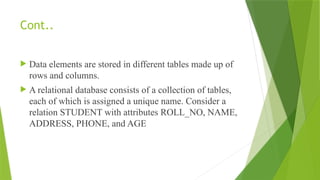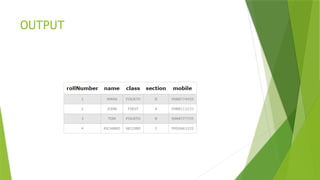relational data model in DBMS AND KEYS.pptx
- 1. RDBMS
- 2. Relational Database Model E.F. Codd proposed the relational Model to model data in the form of relations or tables Developed in 1970 by E.F. Codd, it became commercial in the 80s. After designing the conceptual model of the Database using ER diagram, we need to convert the conceptual model into a relational model The relational data model is a foundational concept in database management that organizes data into one or more tables (or "relations") of rows and columns,
- 3. Cont.. Data elements are stored in different tables made up of rows and columns. A relational database consists of a collection of tables, each of which is assigned a unique name. Consider a relation STUDENT with attributes ROLL_NO, NAME, ADDRESS, PHONE, and AGE
- 4. Cont..
- 5. Important Terminologies Attribute: Attributes are the properties that define an entity. Relation Schema: A relation schema defines the structure of the relation and represents the name of the relation with its attributes. e.g.; STUDENT (ROLL_NO, NAME, ADDRESS, PHONE, and AGE) is the relation schema for STUDENT. If a schema has more than 1 relation, it is called Relational Schema. Tuple: Each row in the relation is known as a tuple. Relation Instance: The set of tuples of a relation at a particular instance of time is called a relation instance.
- 6. Degree: The number of attributes in the relation is known as the degree of the relation. The STUDENT relation defined above has degree 5. Cardinality: The number of tuples in a relation is known as cardinality. The STUDENT relation defined above has cardinality 4. Column: The column represents the set of values for a particular attribute. The column ROLL_NO is extracted from the relation STUDENT. NULL Values: The value which is not known or unavailable is called a NULL value. It is represented by blank space. e.g.; PHONE of STUDENT having ROLL_NO 4 is NULL
- 7. Relation Key: These are basically the keys that are used to identify the rows uniquely or also help in identifying tables. These are of the following types. Primary Key Candidate Key Super Key Foreign Key Alternate Key Composite Key
- 8. Candidate Key The minimal set of attributes that can uniquely identify a tuple is known as a candidate key. For Example, STUD_NO in STUDENT relation. It is a minimal super key. It is a super key with no repeated data is called a candidate key. The minimal set of attributes that can uniquely identify a record. It must contain unique values. It can contain NULL values. Every table must have at least a single candidate key. A table can have multiple candidate keys but only one primary key. The value of the Candidate Key is unique and may be null for a tuple. There can be more than one candidate key in a relationship. The candidate key can be simple (having only one attribute) or composite as well.
- 9. student
- 10. Primary Key There can be more than one candidate key in relation out of which one can be chosen as the primary key. For Example, STUD_NO, as well as STUD_PHONE, are candidate keys for relation STUDENT but STUD_NO can be chosen as the primary key(only one out of many candidate keys). It is a unique key. It can identify only one tuple (a record) at a time. It has no duplicate values, it has unique values. It cannot be NULL. Primary keys are not necessarily to be a single column; more than one column can also be a primary key for a table. Ex-ROLL_NO is a primary key.
- 11. Rules For Defining the Primary Key Minimal: The primary key is composed of a minimum number of attributes Accessible: The primary key is used to check the ability to access and interact with the database. The user must easily create, read or delete a tuple using it.
- 12. syntax for creating the Primary Key CREATE TABLE EMPLOYEE ( Employee_Id int NOT NULL PRIMARY KEY, Name varchar (200) NOT NULL, PAN_NO int NOT NULL Salary int NOT NULL Dept varchar (200) NOT NULL );
- 14. Super Key The set of attributes that can uniquely identify a tuple is known as Super Key. For Example, STUD_NO, (STUD_NO, STUD_NAME), etc. A super key is a group of single or multiple keys that identifies rows in a table. It supports NULL values. Adding zero or more attributes to the candidate key generates the super key. A candidate key is a super key but vice versa is not true. Super Key values may also be NULL.
- 16. Alternate Key The candidate key other than the primary key is called an alternate key All the keys which are not primary keys are called alternate keys. It is a secondary key. It contains two or more fields to identify two or more records.
- 17. Foreign Key If an attribute can only take the values which are present as values of some other attribute, it will be a foreign key to the attribute to which it refers. It is a key it acts as a primary key in one table and it acts as secondary key in another table. It combines two or more relations (tables) at a time. They act as a cross-reference between the tables. For example, DNO is a primary key in the DEPT table and a non-key in EMP It is maintaining refrential integrity.
- 18. A foreign key is a column or a combination of columns in a table that establishes a link between two tables in a relational database. It refers to the primary key in another table The table with a foreign key is called a foreign table/child table/referencing table The table with a primary key that is referenced by a foreign key is called a primary table/parent table /referenced Table. A foreign key can be created during table creation using CREATE TABLE or it can be added to a table later using ALTER TABLE statement
- 19. The syntax to create a foreign key in CREATE TABLE statement is: CREATE TABLE table_name ( column1 datatype, column2 datatype, …, CONSTRAINT fk_constraint_name FOREIGN KEY (column1, column2, …) REFERENCES parent_table(column1, column2, …) );
- 20. Composite Key A table might not have a single column/attribute that uniquely identifies all the records of a table. To uniquely identify rows of a table, a combination of two or more columns/attributes can be used. It still can give duplicate values in rare cases. So, we need to find the optimal set of attributes that can uniquely identify rows in a table. It acts as a primary key if there is no primary key in a table Two or more attributes are used together to make a composite key . A composite key cannot be null.
- 21. SYNTAX
- 23. OUTPUT






















